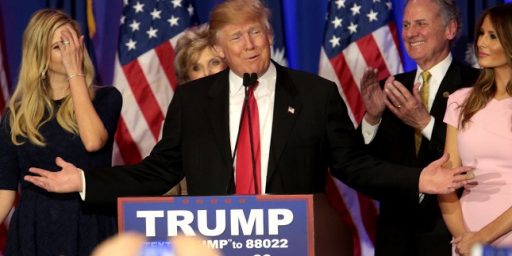Electoral Reform in California
One of the items that has not been discussed all that much this week (what with all the rage to discuss) is the passage of Proposition 14 in California that makes an important change to California’s election process.
First, despite what practically everyone is saying, this is not the creation of a new primary system. It is, in reality, the doing away with primaries totally and replacing it with a modified two-round process to elect officeholders. I say modified because even an absolute majority in the first round will not result in winning office.
To wit: a primary election is a process by which a given party nominates its candidates. It is a narrowing process by which a set of co-partisans compete among themselves to determine who their sole representative will be before the general electorate.
Under the new system there will be no process to winnow partisan fields and effectively the system allows for a self-nomination process.
It certainly is not an ”open primary” (as many have called it). An open primary is properly defined (and has been for decades) as one in which voters do not register in advance with a given political party and can choose, on primary day, which primary they wish to participate in. This is the system, for example, used in both Alabama and Texas (and a large number of other states). A closed primary is one in which voters register ahead as Republicans, Democrats, Libertarians, etc. and are therefore limited to vote in that party’s primary.
Second, the question becomes: what is it? It is a two-round process that takes the top two winners from the first round and pits them against one another in the second round. That could be, by the way, a Dem v. a Dem or a Rep v. Rep. Indeed, that will likely be the outcome in many races going forward. One thing that it will do is utterly eliminate third party candidates from the second round (the one that corresponds to the general election). This will literally be true as with only two candidates on the ballot in the second round, it is impossible to have a third party candidate.
One of the things that this process does is remove the ability of the party’s voters to directly influence which candidates are selected to represent their party. As a commenter at Fruits and Votes accurately described the process “retains party labels on the ballot but puts their use in the hands of candidates rather than the parties themselves.”
It affects all partisan elections in the state, save presidential primaries.
The argument in favor of Top Two (as it is called) is that it will help increase accountability and decrease partisanship/increase moderation. I have my doubts. Indeed, there is no particular reason to assume that this will be the case. As political scientist Barbara Sinclair notes:
To finish in the top two when the number of candidates is large appealing to a fervent base may well be the best strategy — particularly in less visible legislative races. After all, it may not take a very large percent of the vote to finish among the top two. Oh, but then the other, more moderate, candidate will win the general election, the argument goes. But why would we expect the “other candidate” to use a different strategy?
Political Scientist John J. Pitney, Jr. notes: “In states that have tried similar election procedures, there is little evidence that a more moderate political culture has resulted.”
Further, I would point out that the likelihood will remain that the voters who will turn out for the “primary” (i.e., the first round) will still be the more hardcore/partisan/ideological voters as opposed to the larger and likely more moderate voters who turn out for the general election (i.e., the second round). As such, this change does not alter a basic structural aspect of the process (i.e., the electorate that choose the top two is not the same as the electorate that chooses the officeholder–which is true of primaries in general).
It should be noted that this vote is the culmination of a long process over the last decade+ concerning California’s primary system (and now the lack thereof). California had been using what is called a blanket primary, wherein all the candidates for all the offices for all the parties was on one ballot. As such, a given voter could act as part of the Republican Party when choosing a Senate candidate, a Democrat when choosing a House candidate, and a Green for State Assembly, etc. Think of it as a really open primary wherein a voter choosing which party to which they belong per office on the same ballot. This process was declared to have violated the parties’ rights of free association (by forcing them onto the same ballot) by the Supreme Court in California Democratic Party v. Jones, 530 U.S. 567 (2000).
A variation of this system was used for years in Louisiana (but no longer for the US Congress). This system is also used in the state of Washington (which also, at one point, had used the blanket primary system as well).






Certainly, it hasn’t done anything to moderate or improve Louisiana candidate selection.
I know various “open primary” setups have been struck down in court challenges but would imagine this one would survive. But it strikes me as a very bad idea.
Welcome to the ONE Party State, and soon coming to you, One Party governance on the Federal level. It wasn’t the Communists, it was the Socialists after all. Heil!
@James: SCOTUS ruled the LA process as violating federal law in the following sense: at one point if a candidate received an absolute majority in the “primary” stage, they were award the seat. Since this happened prior to the first Tuesday following the first Monday in November, it meant that members of congress were being elected before the official, statutorily required federal election day. This led to a situation in which “primary day” in LA was on election day in November and “election day” was a month later in December for any elections that needed a run-off. This is now no longer the case, as they have gone to a different process for congressional elections.
As I understand Top Two, the top two go to November, regardless of the percentages in question.
This point that you made:
“retains party labels on the ballot but puts their use in the hands of candidates rather than the parties themselves.”
makes me think that this could allow the measure to be struck down by federal courts – it violates the parties’ ability to “freely associate” with those they choose. In fact, hasn’t this created problems for a jungle primary in the past?
I can’t see how this doesn’t violate the parties’ freedom of association – since they are left powerless to stop people from using their party label!
@Brett: Perhaps. Although technically that is the case no matter what (see: the Democratic primary in SC). At the moment if you pay the right fee you can run in a partisan primary and the mechanism to oust (or approve) you is via the primary itself.
Louisiana uses a closed primary with party registration for federal elections since 2006.
But for state and local elections, Louisiana retains its majority-runoff with candidate-selected party labels (aka “jungle primary”). And unless the parties can make an argument with a straight face that they can regulate the partisan preferences of individual citizens, I can’t see how their associational rights are violated.
As far as its effects on Louisiana candidate selection are concerned, LA is one of the few southern states that has retained a split Senate delegation (dating back to the jungle primary) and has not become single-party dominant in statewide elections like most of the “deep south” states have, suggesting at least that it favors candidates that are palatable to the electorate from both parties rather than setting up a general election between candidates preferred by the much narrower (and often unrepresentative of state preferences) party primary electorate.
The case I was thinking of is California Democratic Primary v. Jones. Though it did not address the issue at hand, it put a lot of stake into the idea that parties should be able to affiliate with candidates who they choose. As it is, Orly Taitz could go out, and put the “Democratic Party” next to her name. What makes the situation different than the Dem SC primary is that voters affiliated with the party (who participated in the primary, whether it was closed or open – this is an important distinction in Jones) got to choose who their nominee was.
In any event, I wonder why this convoluted system even makes sense – I would think that something like AV or instant runoff would be much better at accomplishing the stated goals of this reform.
Brett,
There was nothing stopping Orly Taitz from running in the Democratic primary, to be honest, this go ’round should she have chosen to do so.
The SC fellow used the Democratic label whether he won or not.
My point being that even prior to Prop 14’s passage, there was nothing to stop candidates of dubious quality from using the labels if they wanted to to.
I guess my point is that seeking a party’s nomination during a primary is different than affiliating with a party during a general election. If Orly Taitz ran in the Democratic primary, Democratic voters in the primary could reject her, and thus keep her from affiliating/associating with their party in the general election. In the SC example, voters chose to allow the candidate to affiliate with the party in the general. With this new law in CA, all voters (not just participants in the primary – participation, which in Jones, is enough to qualify someone as a “member” of a party, if even for one day) get to decide who appears on the general election ballot as a Democrat. So, I think the problematic element is that party members do not get to decide with whom their organization is associated in a general election.
Brett,
Just to be clear, I am not defending the CA process–I think it is a bad move in general.
However, I think that the issue in CA going forward is that for legal purposes what I am calling the first round is legally deemed the primary. As such, the practical effect on the measure you are discussing is likely legally the same: Taitz could run in the primary as a Democrat and she surely would not have made it to the general election.
The California system as described by the good Doc seems to me to pass the constitutional smell test. I would say however, that not being able to vote straight ticket in November, would encumber by voting time quite substantially. Also Doc, I have no idea what you speak of when talking about South Carolina, but you can’t just pay the fee and run as a Democrat in the state of Alabama. Candidates are rarely rejected, but it happens a few times a cycle.
Tal: fair enough–I am being overly simplistic on that count. I think, for example, that the SC Dem convention could have rejected him.
Indeed, I wonder in CA if there aren’t still provisions under which the party could reject the usage of a given label.
In re: Alabama, the case of Harrianne Smith on the Rep side of things comes to mind.